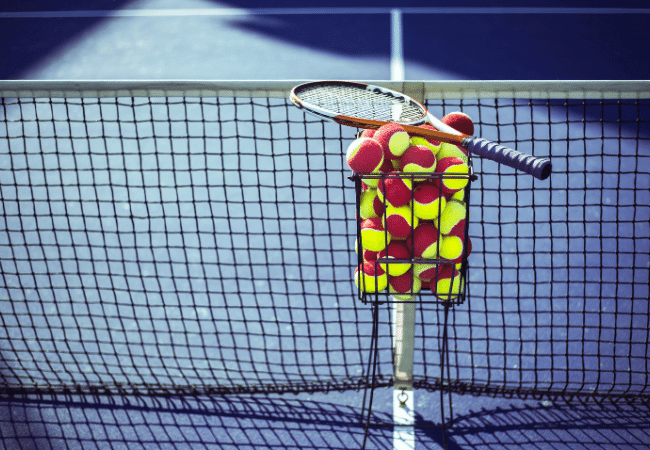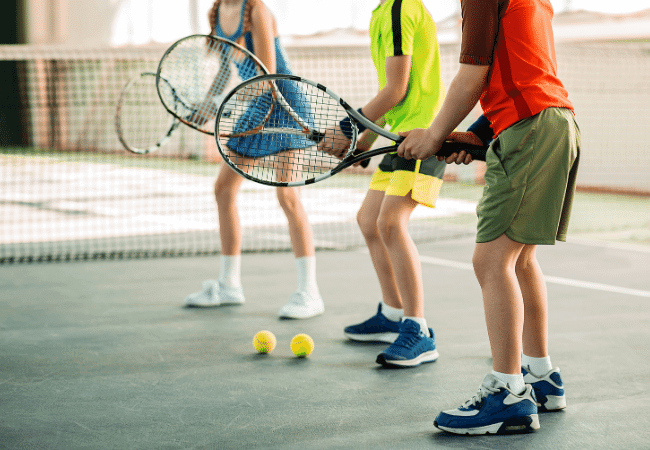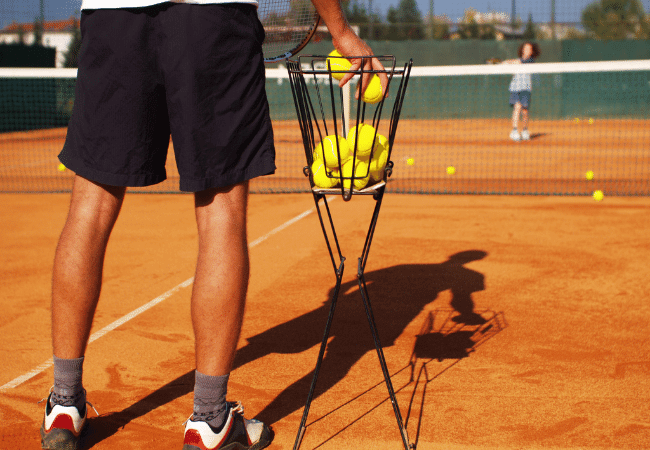Learning to play a new type of sport can be difficult and exciting at the same time.
Every sport comes with different techniques and ways to build your skill level.
If you are looking to get into the sport of tennis or if you want to get some knowledge to help someone you know who wants to get involved in tennis, you came to the right place.
If you are not very familiar with the world of sports you may not know what a drill is.
Sport drills are training exercises to build knowledge and create correct and lasting habits. The adage, “practice makes perfect” is so true.
Repetition – drills – help to make you a better tennis player.
Drills are especially important when you’re a beginner. (But don’t think you’ll stop drilling when you’re no longer a beginner. In tennis, drills are life!)
Contents
Goals of Tennis Drills For Beginners
Tennis drills for beginners can include repetitive activities to help improve your arm movement to improve your swing to accurately hit the ball. Tennis is a skill that takes time. It’s a process to learn, but it can be so much fun while doing so.
When first learning tennis, where the ball lands isn’t all that important. Stroke mechanics, body position, and footwork (getting to the ball) are the focus.
Remembering to be in ready position, split step, bend your knees and look at the ball before hitting it – all things that must be practiced.
Drilling those movements to become second nature will serve you well as you continue with tennis.
Drills can help to improve your hand-eye coordination, speed, and agility on the tennis court.
Beginner Tennis Drills For Kids

Learning new tennis drills for kids can be beneficial for them to get the hang of the sport when they’re young and like a sponge.
There are many ways to add a fun and exciting spin to tennis drills for kids to learn how to play the sport. Tennis is always supposed to be fun and especially when just learning. No drudgery!
These will keep your children entertained the whole time without making it seem like work. With kids, the goal of the drill is most important. Not all drills must be with a racket or a tennis ball.
Most tennis clinics for kids will use tennis balls that are geared for kids. They’ll likely be red and yellow for the younger kids as the ball speed is reduced by 75%. For slightly older kids, the balls will be orange and yellow with a ball speed reduced by 50%. These balls move more slowly and don’t bounce as high as a traditional tennis ball.
Beach Ball Tennis Dodgeball
First on the list of tennis drills for kids is to play a good game of good old-fashioned dodgeball.
This is similar to traditional dodgeball that you may have played in gym class back in the day, but rather than using a kick ball, we’re suggesting you use a beach ball so nobody gets hurt.
You can have an adult — such as yourself or a more experienced player — take a tennis racket and hit a beach ball toward the kids while they try to dodge the ball from hitting them.
The first goal is for the kids to not be hit by the ball. The second goal would be for them to catch the ball. Thirdly, them running after the ball once they’ve dodged it gets them moving!
This activity can help your aspiring junior tennis player to practice their footwork by reacting to the incoming balls.
This exercise will enforce the idea of quick feet whether they move away from the ball, move toward it to catch it, or run after it!
Dribble the Tennis Ball
A concept taken from basketball is that of dribbling. Basketball requires that players continue to bounce the ball whenever moving about the court.
Since hand-eye coordination is so important in tennis, bouncing a tennis ball with a racket is a good way to learn hand-eye coordination while a beginner tennis player is getting comfortable holding a tennis racket.
Each child should start with the racket in their dominant hand. Bounce the ball down to the court with the tennis racket. A solid goal would be for each beginner to hit the tennis ball 10 times with their racket.
This drill will likely take some patience for the kids as well as any supervising adults as it’ll take time for beginners to maintain control.
Frying Pan Tennis Drill
This is the opposite movement of the dribble, but hand-eye coordination and control are still the goals.
Rather than bouncing the ball down to the ground, the goal with this drill is to bounce the tennis ball off the strings up into the air repeatedly.
Start with the dominant hand and place a tennis ball on their string bed. The racket face must be held perpendicular to the ground or the tennis ball will roll off the surface. Move the racket up to get the ball into the air. When it comes down, it should bounce on the strings.
Try to hit 10 in a row. See who can bounce the ball the most times.
I’m sure you’ll have a few who want to see how high they can hit it. There’s one in every group…!
If you’re very brave, suggest using the non-dominant side to hold the racket. There will definitely be some running after tennis balls…
Drilling Forehands and Backhands

At some point kids do need to hold the racket and attempt to hit the ball over the net. Initially tossing a ball to a child to hit will likely work better than feeding a ball with a racket. There’s just more control and the toss won’t come at them so quickly.
Have each child hit 3 forehands and get back in line. Once you’ve gone through the line a few times, switch to backhands.
Whether kids or adults, repetition is key. Enforce watching the ball and being ready for anything!
Beginner Tennis Drills For Adults

Looking to get started playing tennis but aren’t interested in the kiddie games because you’re no longer a kid yourself?
You may not be a kid, but since tennis takes time to learn, you’ll still have to start at the beginning.
The Dribble and Frying Pan have benefits for adults as well. Hand-eye coordination, understanding how to grip the racket, controlling the ball – are all components of learning tennis no matter your age.
Half the Court
Using only part of the court is underutilized in my opinion. Hitting a full groundstroke can be a lot of pressure when first learning to play tennis. By reducing the space for play, there’s less distance to cover and control is the goal.
This is a multiplayer drill that often happens in adult tennis clinics. It can be done with only 2 people, but up to 4 (plus an instructor) can be on court at the same time. If 4 people are participating all players will stand individually in one of the services boxes.
The instructor feeds a ball to one of the players. The goal is for that player to hit the ball over the net, but the service line is as far back as the ball can go. Beyond the service line and the ball is out and play begins again for the next point.
Volleys and touch shots will be the name of this game. Assuming you’ve got a small group of beginners, score to 10 and switch up the player combos.
This drill gets beginners feeling the space of the court, watching for the ball, and controlling their shots rather than hitting too hard.
Volley Drill

Volleys are so much fun and are less mechanical than a groundstroke. If hit correctly, there’s a lot less movement that occurs with the arm.
Volleys are more like a blocking motion than a swinging motion. You almost catch the ball on your racket rather than swinging through it.
Feed a forehand ball to a player standing just inside the service line near the T. The player should start out in ready position, do a split step with the racket out in front of their body aligned vertically just below chin level. A big swing shouldn’t occur – the player should block the ball. The racket shouldn’t be gripped too tightly in their hands.
Volleys take time to get the hang of, but with practice, they’ll come.
This drill emphasizes ready position, split stepping, “light on your feet” footwork, and hand eye coordination.
Groundstroke Drill
This is a partner drill. Have your partner toss the ball toward your forehand side from 10-feet away.
Allow the ball to bounce, catch it and immediately throw it back to your partner.
Your partner does the same – allows the ball to bounce, catches it and immediately throws it back.
After each of you have successfully thrown and caught the ball, you both move back a foot and repeat the drill.
As the drill progresses, the speed of each toss should increase and the distance obviously will as well.
Once you’ve mastered this, move on to hitting groundstrokes back and forth rather than throwing the ball to each other.
Since both players are beginners, it often works best when one partner hits while the other partner tosses.
Switch so each player gets a turn to hit. If you’re both ok with running after tennis balls here and there due to inconsistent shots, go for it.
Tennis is about enjoying yourself on court. Don’t take yourself too seriously. It’s fun!
Final Word
The list of tennis drills for beginners can go on for days. When first starting to play tennis, it’s about getting comfortable holding a racket and focusing a lot on hand-eye coordination.
Whether you’re in a more formal clinic setting, playing with friends, or hitting against a backboard, be open to all kinds of drills or exercises to familiarize yourself with the court dimensions and how comfortable you are holding the racket.
Don’t think that drills will end once you’re no longer a beginner. Drills will be a component of tennis as your skill level progresses. Building up your strength and confidence go a long way to being comfortable on the tennis court.
There are so many effective tennis practice drills that you wouldn’t even think could help with coordination, speed, agility and more.
Go ahead and try out some of these drills today. Any opportunity to learn on the tennis court is a good time!

